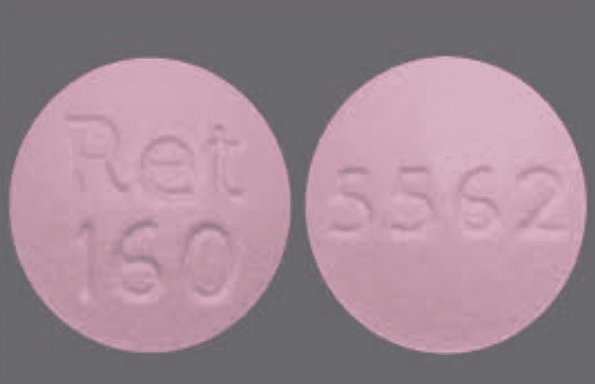Retevmo and Alcohol/Food Interactions
There are 2 alcohol/food/lifestyle interactions with Retevmo (selpercatinib).
Selpercatinib Food/Lifestyle
Major Food Interaction
GENERALLY AVOID: Grapefruit juice may increase the plasma concentrations of selpercatinib. The proposed mechanism is inhibition of CYP450 3A4-mediated first-pass metabolism in the gut wall by certain compounds present in grapefruit. Inhibition of hepatic CYP450 3A4 may also contribute. The interaction has not been studied with grapefruit juice, but has been reported for other CYP450 3A4 inhibitors. When a single dose of selpercatinib (160 mg) was coadministered with multiple doses of itraconazole (200 mg once daily), a potent CYP450 3A4 inhibitor, selpercatinib peak plasma concentration (Cmax) and systemic exposure (AUC) increased by 30% and 133%, respectively. Based on pharmacokinetic modeling, administration of multiple doses of selpercatinib (160 mg twice daily) with multiple doses of the moderate CYP450 3A4 inhibitors diltiazem (60 mg three times daily), fluconazole (200 mg once daily), or verapamil (80 mg three times daily) is predicted to increase selpercatinib Cmax by 46% to 76% and AUC by 60% to 99%. In general, the effect of grapefruit juice is concentration-, dose- and preparation-dependent, and can vary widely among brands. Certain preparations of grapefruit juice (e.g., high dose, double strength) have sometimes demonstrated potent inhibition of CYP450 3A4, while other preparations (e.g., low dose, single strength) have typically demonstrated moderate inhibition. Increased exposure to selpercatinib may increase the risk of serious adverse effects such as QT interval prolongation, liver transaminase and bilirubin elevations, hypertension, hemorrhage, edema, and hypersensitivity reactions (e.g., fever, rash, arthralgias/myalgias with concurrent decreased platelets or transaminitis).
MANAGEMENT: Until further information is available, it may be advisable for patients to limit or avoid consumption of grapefruit and grapefruit juice during treatment with selpercatinib.
References (4)
- (2024) "Product Information. Retevmo (selpercatinib)." Lilly, Eli and Company
- (2023) "Product Information. Retevmo (selpercatinib)." Eli Lilly Australia Pty Ltd, vA1.0
- (2024) "Product Information. Retsevmo (selpercatinib)." Eli Lilly and Company Ltd
- (2024) "Product Information. Retevmo (selpercatinib)." Loxo Oncology Inc
Switch to consumer interaction data
Selpercatinib High Blood Pressure (Hypertension)
Moderate Potential Hazard, Moderate plausibility
selpercatinib - hypertension
Selpercatinib may cause hypertension and therapy should not be initiated in patients with uncontrolled hypertension. Care should be exercised when using this agent in hypertensive patients. Optimize blood pressure before starting treatment. It is recommended to monitor blood pressure after 1 week, and regularly as clinically indicated. Initiate or adjust anti-hypertensive therapy as appropriate. Withhold, reduce dose, or permanently discontinue treatment based on the severity.
References (1)
- (2024) "Product Information. Retevmo (selpercatinib)." Lilly, Eli and Company
Switch to consumer interaction data
Retevmo drug interactions
There are 634 drug interactions with Retevmo (selpercatinib).
Retevmo disease interactions
There are 7 disease interactions with Retevmo (selpercatinib) which include:
- bleeding
- hypertension
- ILD/pneumonitis
- liver dysfunction
- tumor lysis syndrome
- Selpercatinib – arrhythmias
- Selpercatinib – renal dysfunction
More about Retevmo (selpercatinib)
- Retevmo consumer information
- Check interactions
- Compare alternatives
- Pricing & coupons
- Reviews (4)
- Drug images
- Side effects
- Dosage information
- During pregnancy
- FDA approval history
- Drug class: multikinase inhibitors
- Breastfeeding
- En español
Related treatment guides
Drug Interaction Classification
| Highly clinically significant. Avoid combinations; the risk of the interaction outweighs the benefit. | |
| Moderately clinically significant. Usually avoid combinations; use it only under special circumstances. | |
| Minimally clinically significant. Minimize risk; assess risk and consider an alternative drug, take steps to circumvent the interaction risk and/or institute a monitoring plan. | |
| No interaction information available. |
See also:
Further information
Always consult your healthcare provider to ensure the information displayed on this page applies to your personal circumstances.


